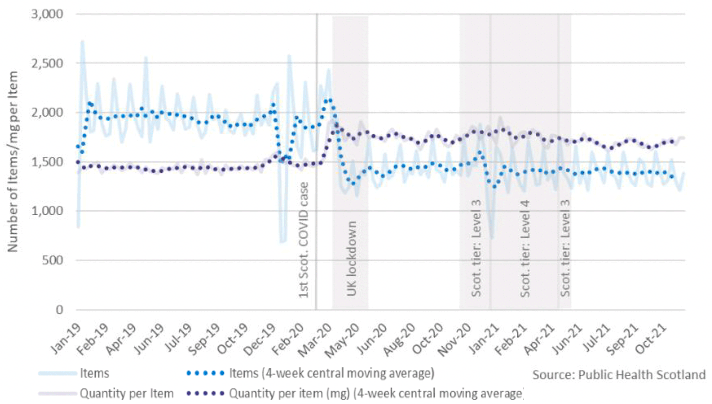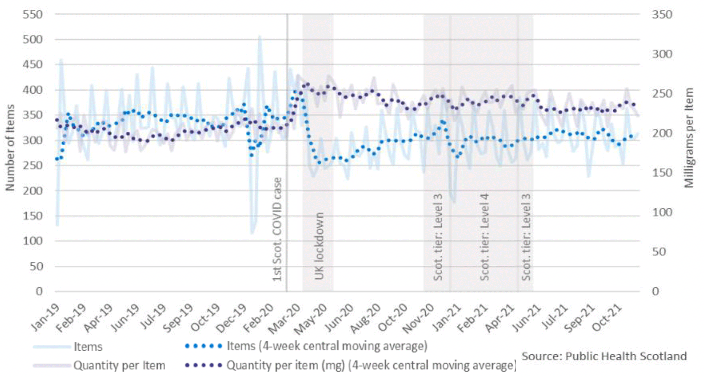Opioid Substitution Therapy (OST) implicated deaths and prescribing: evidence review
This paper summarises current knowledge of trends around methadone and buprenorphine related deaths and changes to prescribing practice in Scotland.
3. Understanding prescribing practices
3.1 Number of people prescribed OST
OST patient estimates and prescribing data are available on the Scottish Public Health Observatory.[17] In the most recent estimates in 2020/21, OST was prescribed to a minimum number of 29,416 people in Scotland. Estimates have been in the range of approximately 29,250 to 29,750 people prescribed OST each year since 2016/17. In 2020/21, the local authorities where the highest number of people prescribed OST lived were Glasgow City (5,993); City of Edinburgh (3,143); and Fife (1,756). NHS Board areas where the highest number prescribed OST lived were NHS Greater Glasgow & Clyde (8,932), NHS Lothian (4,888) and NHS Grampian (2,821).
In 2020/21, methadone 1mg/ml solution was prescribed to a minimum of 24,128 individuals in Scotland. This figure is a decrease from 2011/12, when the estimate was 26,197, although data should be treated with caution due to the variable quality of the underlying data.[18]
Conversely, the estimated number of patients in receipt of buprenorphine has increased over the same time period. In 2020/21, buprenorphine was prescribed to a minimum of 6,312 individuals, while in 2011/12 the estimate was 2,375, an increase of 166% over the time series.
Annual data on OST drug prescribing and defined daily doses also demonstrate the shift from methadone to buprenorphine. The percentage of OST defined daily doses associated with methadone decreased from 97% in 2011/12 to 88% in 2020/21. Over this time period, there were changes in the OST treatments offered by NHS boards in Scotland, with an increase in prescriptions for medications containing buprenorphine. The percentage of OST defined daily doses that were associated with buprenorphine (either buprenorphine and naloxone combined (Suboxone) or buprenorphine) increased from 3% in 2011/12 to 11% in 2020/21.[19] PHS continue to make improvements to OST data collection to improve surveillance and oversight.
3.2 Changes to prescribing and dispensing practice in response to the pandemic
In response to the COVID-19 pandemic Scottish Government ensured that OST (and injecting equipment provision) remained essential services. This was underlined in a letter from the Public Health Minister and Interim Chief Medical Officer to ADPs, HSCPs and Joint Boards in April 2020.[20]
However, challenges exist in balancing risk of death from overdose in absence of medication against the risks posed by COVID-19, particularly while accounting for the risks to all vulnerable patient groups using pharmacies and pharmacy staff. At the start of the first lockdown in March 2020, community pharmacies implemented social distancing measures to manage customer throughput and minimise contact risk for COVID-19 for all patients, customers and staff. For people prescribed an OST medication, subject to risk assessment, this included moving some patients from daily supervised dispensing within pharmacies. Alternatives included a move to take home supply; an increase of take home supply (to reduce the frequency of attendance) and doorstep delivery of OST (particularly for vulnerable/shielding patients).
Guidance on this move and other COVID-19 contingency planning was published by Scottish Drugs Forum in collaboration with the Sexual Health and Blood Borne Virus Prevention Leads Network, co-ordinated by the Scottish Health Protection Network with advice from the Drug Deaths Task Force MAT subgroup.[21]
The move away from supervised dispensing is evident from prescribing data which suggest that OST prescribing continued in similar quantities throughout the COVID-19 lockdown period. However dispensing arrangements – modified following the introduction of social distancing measures – led to a reduction in the number of items prescribed. Figure 7 and Figure 8 below show a clear switch in April 2020, with an increase in the quantity per item and decrease in number of items prescribed. This shift has largely persisted since.

OST prescribing data are now available on the PHS Covid wider impact dashboard where it can be explored in more detail with regional breakdowns.[22]
Robust evidence surrounding the impacts of take home supply and remote prescribing practices for OST patients in Scotland and elsewhere, particularly in the context of the pandemic, remains extremely limited and it is important to note the complexity of establishing a correlation in the context of multiple confounding factors.

A limited number of UK-based and international studies relating to take home supply have explored potential implications for patients, including risk of increased mortality, the attitudes and perceptions of providers and risk of prescription diversion. For example, a 2020 evidence review outlined a number of possible harms associated with take home prescribing during the pandemic, namely that larger dispenses may increase the risk of overdose; that people were likely to have difficulty taking medication as prescribed; that people may face pressure to sell or share their supply; and that people experiencing homelessness were unlikely to have safe storage options.[23] In multiple studies, providers surveyed reported concerns around patient safety and the impact of unsupervised dispensing on delivering person-centred care, while others were broadly supportive.[24]
A 2006 study evidenced positive outcomes for take home supply, including increased treatment retention rates and increased patient satisfaction.[25] The authors' recommendations to increase options for take home supply were broadly echoed in a more recent US-based study that found no evidence of increased harms as a result of remote prescribing during the pandemic, although videoconferencing was used to supervise consumption on a regular basis.[26] However, there remains little consensus, and a paucity of evidence, on the benefits and harms of take home supply. Understanding the potential impacts of changes in prescribing practices for OST patients constitutes an important line of enquiry in understanding the rise of methadone-implicated deaths.
Contact
Email: socialresearch@gov.scot
There is a problem
Thanks for your feedback